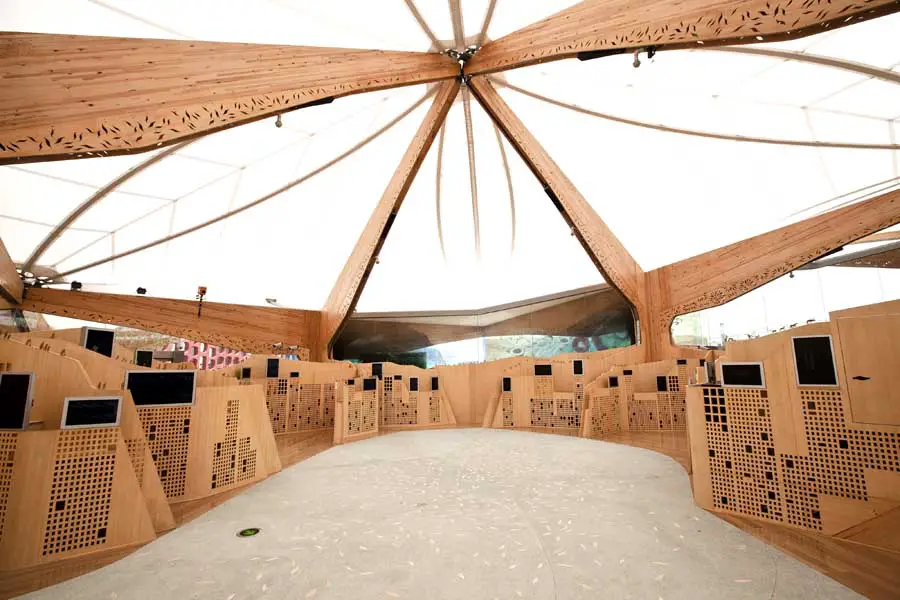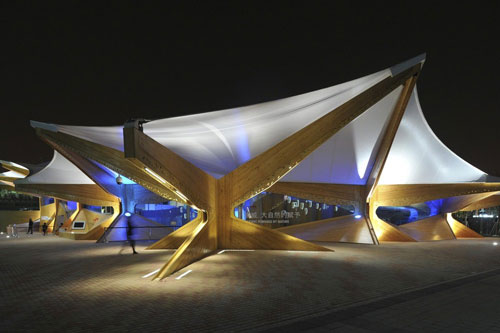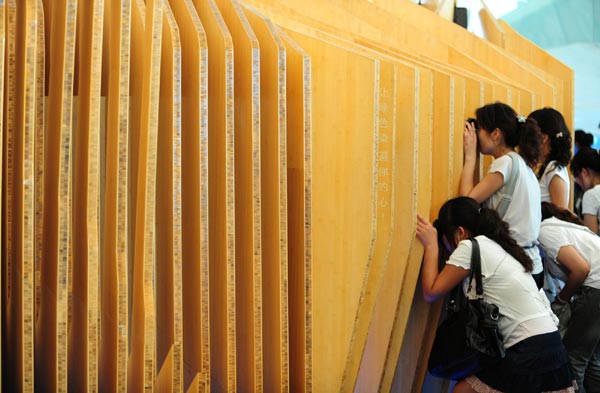Vinaros Microcoasts in Vinaròs, Castellón, Spain. These steel supported wooden islands bring an inviting quality to the Spanish coast. The islands are composed of hexagonal flat planes with a tessellated wood pattern. Some of the parts are folded upwards to provide places to lean against and offer a variety of uses. These platforms show the powerful connection that humans can have with wood and how a simple material can help change a way a space feels and is experienced.
Saturday, February 1, 2014
Bobby Esposito: Looking Out Week 3
In response to a receding, increasingly uninhabitable coastline, Guallart Architects created the
Vinaros Microcoasts in Vinaròs, Castellón, Spain. These steel supported wooden islands bring an inviting quality to the Spanish coast. The islands are composed of hexagonal flat planes with a tessellated wood pattern. Some of the parts are folded upwards to provide places to lean against and offer a variety of uses. These platforms show the powerful connection that humans can have with wood and how a simple material can help change a way a space feels and is experienced.
Vinaros Microcoasts in Vinaròs, Castellón, Spain. These steel supported wooden islands bring an inviting quality to the Spanish coast. The islands are composed of hexagonal flat planes with a tessellated wood pattern. Some of the parts are folded upwards to provide places to lean against and offer a variety of uses. These platforms show the powerful connection that humans can have with wood and how a simple material can help change a way a space feels and is experienced.
Carter Nelson: Assignment 03
Woodwork evokes a feeling of warmth, connection to nature, luxury, tradition, and strength that no other material brings to the table. The tradition of woodworking has evolved as technology has evolved.
It began by using methods of stacking whole logs. This use came out of a degree of simplicity. See the stavkirke church below what uses wooden staves as its basis for construction. These were erected as early as the twelfth century in Norway and are feats of architecture due to their simple use of material, structural properties, durability, and by virtue of how quickly and easily they can be erected.

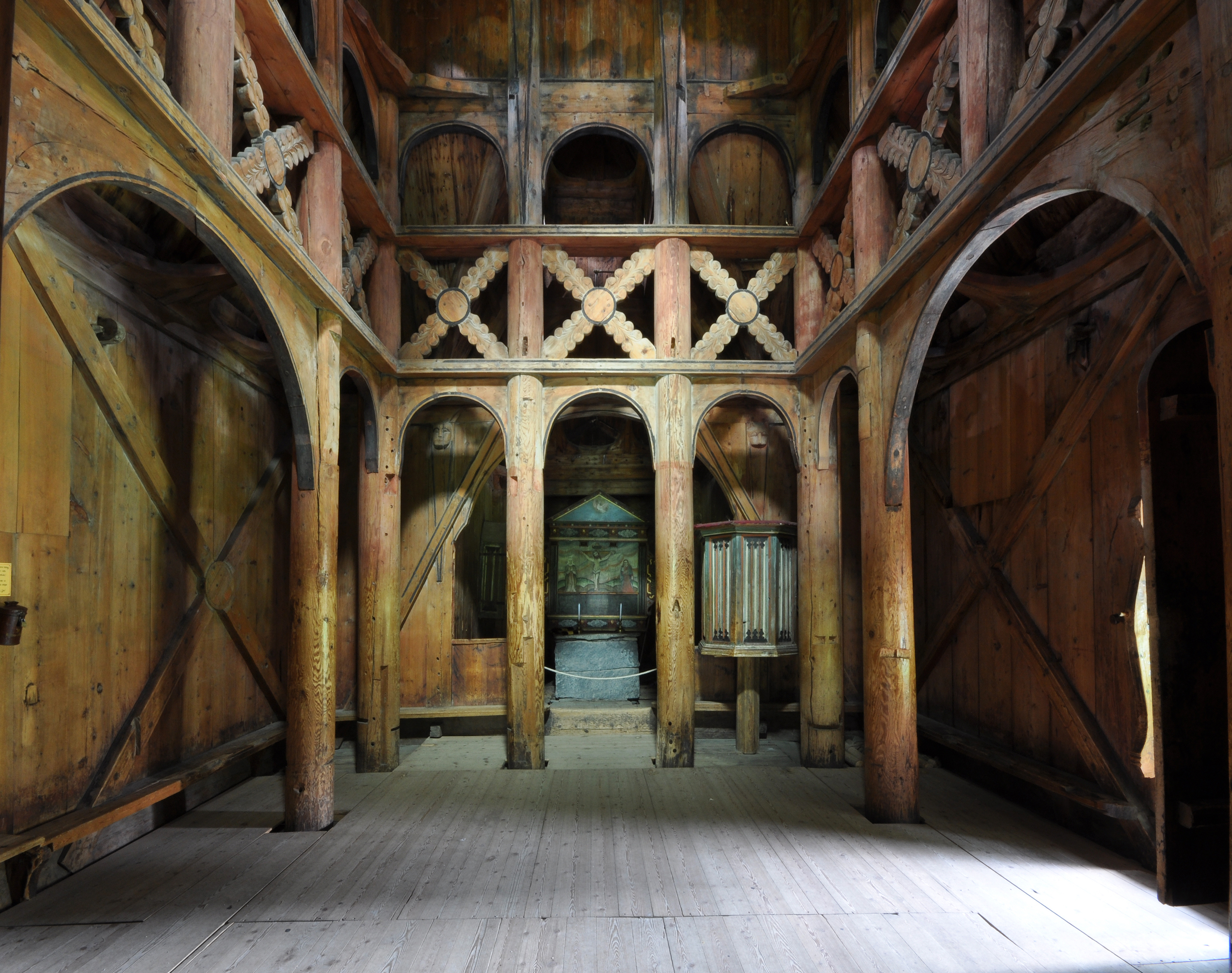
Following this use of wood came the idea of using a unit or sets of units for framing construction and joinery techniques. Wood framing systems came out of this sort of use for wood.

More recently we are looking at new ways of using wood through fabrication to imply different aesthetic and structural systems.
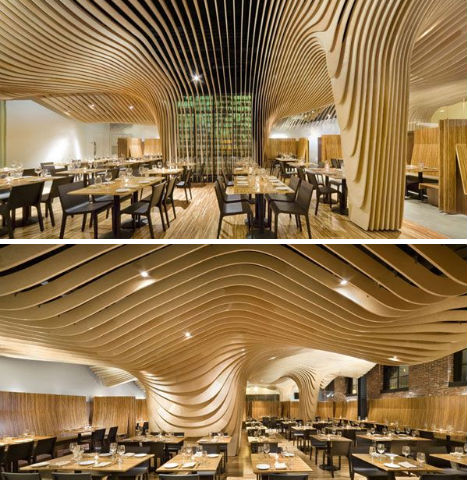
This is an extremely simple evolution of the use of wood in construction. from whole logs, to units, to hardly recognizable materials, wood has provided a unique and always relevant material palate to architecture across the world.
It began by using methods of stacking whole logs. This use came out of a degree of simplicity. See the stavkirke church below what uses wooden staves as its basis for construction. These were erected as early as the twelfth century in Norway and are feats of architecture due to their simple use of material, structural properties, durability, and by virtue of how quickly and easily they can be erected.


Following this use of wood came the idea of using a unit or sets of units for framing construction and joinery techniques. Wood framing systems came out of this sort of use for wood.

More recently we are looking at new ways of using wood through fabrication to imply different aesthetic and structural systems.

This is an extremely simple evolution of the use of wood in construction. from whole logs, to units, to hardly recognizable materials, wood has provided a unique and always relevant material palate to architecture across the world.
Friday, January 31, 2014
Daniel Ha: Looking Out Week 3
Egg Chapel in Munho-ri, South Korea (Near Seoul).
Architect: Andrew MacNair
Built by Shipbuilders, assembled by local family.
The best part of this project was that it was made by the locals. Sure the architect thought up of the idea, but the shipbuilders handcrafted the wood into the shape they need to be and a local family assembled it all on site. This would not have been possible if the material was something like steel or concrete. Those materials need people who have the experience and the skill (welding and casting).
Architect: Andrew MacNair
Built by Shipbuilders, assembled by local family.
The best part of this project was that it was made by the locals. Sure the architect thought up of the idea, but the shipbuilders handcrafted the wood into the shape they need to be and a local family assembled it all on site. This would not have been possible if the material was something like steel or concrete. Those materials need people who have the experience and the skill (welding and casting).
Assigment 3 Scott Holmes
Freeze stability, shelf life, color, cure time, flexibility, grain, moisture content, how it breaks, density, ease of working, durability, bacterial resistance, oil content, elasticity, cost, weight, modulus of rupture(bend strength) , and general aesthetics are all things to consider when working with wood. We all know about the softness of the poplar, but we don't know about its structural qualities which sucks. Wood allows you to an amazing amount of things. It's can be carved, joined, finished, bent, twisted , cut, the possibilities are endless and its fricken awesome.



Kirk Newton: Looking Out Week 3
Sometimes the simplest, most ubiquitous objects are the most overlooked. Oki Sato, lead designer at Nendo developed the rassen chopstick with a spiral end that enables the two chopsticks to intertwine into one product, creating a product formally beautiful, as well as functionally compelling.




Shout out to Minimalissimo.




Shout out to Minimalissimo.
Assignment 2: Crawford Notch | Kirk Newton
Crawford Notch has a long history of being used as an escape into nature, given its location on the east coast and proximity to major east coast metropolitan areas, including New York City and Boston, with it being referred to as the "birthplace of outdoor recreation." Given that this location contains the longstanding Notchland Inn, Highland Center Lodge and the nearby Mount Washington Hotel as the main local nodes, what does this, combined with observations on local Pittsburgh hiker culture indicate?
Pictured above is the Notchland Inn (notchland.com), a series off curated cottages offering "all the luxury of a grand resort but the cozy feel of a bed and breakfast." The inn features an in house naturalist to give professional recommendations to guests for hiking and swimming in Crawford Notch.
If New England rustic pastiche isn't your thing and you prefer a more overt brand of indulgent luxury, the Mount Washington Hotel awaits. The hotel, originally built in 1902, but reconstructed several times after a series of fires, is "one of the few remaining luxury hotel resorts in New Hampshire." Here, one can find repose and indulge in activities including horseback riding, golf, or tennis, amongst other activities.
Closest to the proposed Saco Lake Bath site is the Appalachian Mountain Club Highland Center, listed as one of the top fifty ecolodges in the world, furnished with designs by L.L. Bean. Here, guests have access to hiking, snowboarding and camping supplies in the L.L. Bean gear room.
Speaking of name-dropping brands, this brings the discussion back to Pittsburgh, and the local hiking culture. There's a limited number of outdoor supply stores in the city, but the most popular by far, and the most appropriately stocked is REI. Anecdotally, this is essentially the best and only store in Pittsburgh specifically geared towards wilderness activities.
Thus comes the point: hiking is and always has been geared towards the upper crust who have the financial means to buy the necessary equipment and the ability to drop everything and go to the middle of nowhere for fun. The hotels in Crawford Notch reinforce this impression of a wealthy hiker culture; despite all of their differences visually, all of the major hotels feature splash pages showcasing luxury and invoking an "escape" from the daily grind. The people going to Crawford notch are not wandering souls, living their life on the edge, but rich, stressed, and slightly overweight people dressed up in the finest Gore-Tex windbreakers, Patagonia leggings, and L.L. Bean boots, dragging with them their George Foreman portable kerosene stoves and Marmot Limelight 3P tents.
How can this inform the design of the bathhouse? Visitors to Crawford Notch probably have some expectation as to the relative comfort of their experiences, given the local lodging competition, meaning care must be taken to create an experience that, while integrated with nature and somewhat rustic, cannot be an austere experience.
 |
| Who doesn't want to stay in a charmingly rustic cabin in the woods? |
Pictured above is the Notchland Inn (notchland.com), a series off curated cottages offering "all the luxury of a grand resort but the cozy feel of a bed and breakfast." The inn features an in house naturalist to give professional recommendations to guests for hiking and swimming in Crawford Notch.
 |
| Go ask the caretaker about his axe. |
If New England rustic pastiche isn't your thing and you prefer a more overt brand of indulgent luxury, the Mount Washington Hotel awaits. The hotel, originally built in 1902, but reconstructed several times after a series of fires, is "one of the few remaining luxury hotel resorts in New Hampshire." Here, one can find repose and indulge in activities including horseback riding, golf, or tennis, amongst other activities.
 |
| It's like a cabin with elaphantitis. |
Closest to the proposed Saco Lake Bath site is the Appalachian Mountain Club Highland Center, listed as one of the top fifty ecolodges in the world, furnished with designs by L.L. Bean. Here, guests have access to hiking, snowboarding and camping supplies in the L.L. Bean gear room.
 |
| Recreationaling the outdoors since 1938. |
Thus comes the point: hiking is and always has been geared towards the upper crust who have the financial means to buy the necessary equipment and the ability to drop everything and go to the middle of nowhere for fun. The hotels in Crawford Notch reinforce this impression of a wealthy hiker culture; despite all of their differences visually, all of the major hotels feature splash pages showcasing luxury and invoking an "escape" from the daily grind. The people going to Crawford notch are not wandering souls, living their life on the edge, but rich, stressed, and slightly overweight people dressed up in the finest Gore-Tex windbreakers, Patagonia leggings, and L.L. Bean boots, dragging with them their George Foreman portable kerosene stoves and Marmot Limelight 3P tents.
How can this inform the design of the bathhouse? Visitors to Crawford Notch probably have some expectation as to the relative comfort of their experiences, given the local lodging competition, meaning care must be taken to create an experience that, while integrated with nature and somewhat rustic, cannot be an austere experience.
Gary Li: Looking Out Week 3
We have lost touch with our primitive roots in how we immediately jump to technology wherever it is available. Wood is no longer hand-carved and instead carved by a programmed machine. Sure machines are more accurate, more time efficient, and simpler to make. However the imperfections made by human hands, in my opinion, should be more valuable than the perfection by a machine. Seeing imperfections within a piece makes one wonder how something was made. Respect to those who still hand-carve.
Here are a few hand-carved pieces by Aleph Geddis.
Here are a few hand-carved pieces by Aleph Geddis.
Thursday, January 30, 2014
Looking Out: Week 3
Interior of Steel Cactus (restaurant), Shadyside, Pittsburgh, PA
Complementing the "damn good" Mexican food and favorite local slurp ( the "Yinzerita" )is the warm décor made of 100 year old wood and riveted steel for its finishes. "Who knows what authentic is?" partner Adam DeSimone said about the restaurant's tagline. "We missed the boat on that." While this is not a traditional Mexican wall treatment, the smooth surface interrupted by slight changes in depth with altering tones of red, black and yellow transcend the gentrified (read generic) village of Shadyside... and the wood is really old.
(Read more: http://www.post-gazette.com/life/restaurant-reviews/2012/10/25/On-the-Table-Steel-Cactus-identity-problem-is-it-a-restaurant-or-a-bar/stories/201210250259#ixzz2rxVwnyfx)
-Chloe
Aileena Gray: Looking Out Week 2
The Curtain Door
The Matharoo Associates- an architectural firm in India- designed this swinging door. In form it looks like a curtain, but structurally it is anything but flimsy. Comprised of 40 planks of Burma teak wood the door is held together by wire- almost like beads on a string, which allows the individual parts to move fluidly in a curtain-like fashion. When it is fully closed the door simply looks like a flat wooden surface. The illusion is probably what I appreciate the most; the architects found a way to make the door appear floating as it just graces the neighboring walls. (Supposedly the door is balanced with a hidden counter weight.)
The Matharoo Associates- an architectural firm in India- designed this swinging door. In form it looks like a curtain, but structurally it is anything but flimsy. Comprised of 40 planks of Burma teak wood the door is held together by wire- almost like beads on a string, which allows the individual parts to move fluidly in a curtain-like fashion. When it is fully closed the door simply looks like a flat wooden surface. The illusion is probably what I appreciate the most; the architects found a way to make the door appear floating as it just graces the neighboring walls. (Supposedly the door is balanced with a hidden counter weight.)
2: Ethnography of the Notch
- culture is influenced by climate
- Notchians experience extreme winters
- this winter has been a polar vortex
- maybe I can empathize/reflect
I regularly walk 0.7 mi to get from home to school and I "hike" up a steep hill to get there. I'd say the change in elevation is about 100' (I haven't measured it). The hike from the trailhead to the lake is approximately 650' ( twice the distance from the bottom of my hill to the top) with an elevation change of approx. 150'. If I were to walk up (or down) my hill one and half times I'd probably understand a little of what it would be like to do so in the Notch. Instead of doing this myself, I outsourced and recorded a test subject reaction (see video).
Based on my little experiment (active research) I would say that it is likely pretty physically demanding to climb such an icy and steep slope without a built trail or partially enclosed walkway in the winter. I would also think that perhaps the mudroom of this bathhouse would accommodate thawing before demanding the removal of clothing-- perhaps a fireplace or source of dry-heat, a seating area to catch one's breath, a rack for shoes that dries them by the time the hikers return from the baths, and/or a welcome cup of tea.
-Chloe
Assignment 2: Crawford Notch: Madhura Kharche
The Crawford Path is one of the most well-known hiking paths in North America. The AMC Highland Center lodge provides accommodations for hikers and other visitors and is located in close proximity to the Saco Lake and Mt.Washington.
A young hiker looking at the AMC Highland Lodge over Saco Lake
The Crawford notch is a continuous valley between the White mountains near New Hampshire. The Saco river originates at the Saco Lake and flows through this notch.
Crawford notch and Saco river
This image of the Crawford notch reminds me of my hike on the Franz Joseph Glacier in New Zealand. The trail overlooked a similar "notch" like valley between the Southern Alps.
A river joining the Tasmanian Sea: View from Franz Joseph - Fox Glacier, NZ
My fellow hikers
Besides individual skill, hiking also requires team building and group effort. Trail names help hikers get to know one another on an informal level. These are names usually adopted by or given to hikers. Some examples of trail names include “The Wild Turkey,” “Bamaman,” “Way Seeker,” “Mountain Dew” and “Bird Man.”
Saco Lake and Elephant Head
These observations could potentially inform my design proposal for the bathhouse project in a way that acknowledges the habits and cultures of these visitors. For example, the mudroom could have lockers with a board where people could write their trail names on. The slope of the site around the lake and the path could be replicated into the design, which then becomes an extension of the site, rather than merely a building sitting on a beautiful location.
Polynesian spa in Rotorua, NZ
Canoeing in Saco Lake
People canoeing in the lake could probably have access to the bath house. Distant views of the mountains and lake could dictate the positioning of windows and public spaces.
A Google image of a spa I visited after my hike
View from the spa
Labels:
Assignment 2,
Crowford Notch,
Madhura Kharche,
New Hampshire
Looking Out - Week 3 - Charmaine Y
Helen & Hard Architects designed this pavilion to represent Norway at the Shanghai World Expo of 2010, the expo had the theme of "Better City, Better Life" with a focus on sustainable urban design. The use of wood panels in this design really emphasizes the concept of sustainable design because the pavilion can easily be assembled and disassembled and the materials can be reused after its temporary use for the expo. The materials used in the pavilion is from 15 trees and each piece has a functional use. The architects also used the space between each panel for exhibition, allowing visitors to interact with the pavilion and the materials. This pavilion was awarded the Silver Medal within the expo for best design.
Chandler Archbell: Assignment 2
Hiking is an activity suited to people of various abilities and interests. Some hikers enjoy leisurely strolls along safe, well maintained paths while other more extreme hikers must be prepared for whatever nature throws at them. No matter what, hiking is an opportunity to step away from everyday life and experience the essence of this rugged, wild thing we call nature. The White Mountain National Forest in New Hampshire is home to many hiking trails, waterfalls, fishing areas, and breathtaking views of mountains that hikers of all abilities can enjoy. The Crawford Path, cleared in 1819, is the oldest continually used and maintained hiking path in the US. Just across from the beginning of this path is the AMC Highland Center lodge, which offers various accommodations from private rooms to hostel-style bunk rooms. This lodge has a family feel: they serve family-style dinners and have lots of shared rooms for people to meet. Walking into this friendly atmosphere the perfect end to a long day of experiencing nature.
The beautiful Highland Center
The beautiful Highland Center
Family-style dinners allow guests to interact
Hiking trails appropriate for all ages
Looking Out: William Aldrich
Yeta Log Cabin by Lab Zero

The small structure you see above is a portable, multipurpose, "roof over your head." The compact dwelling, although tiny, contains all the modern conveniences one desires while trying to live comfortably. This includes a kitchen, bathroom, shower, and even solar panels. It runs on its own renewable electricity, collects its own rain water, and is lit by sunlight through the large glass panel doors during the day. The wood is left untreated and when the front 'gate' is closed, its looks as thought it is no more than a pile of logs. Completely unsuspecting and amazingly environmental and efficient. The home of the future?



The small structure you see above is a portable, multipurpose, "roof over your head." The compact dwelling, although tiny, contains all the modern conveniences one desires while trying to live comfortably. This includes a kitchen, bathroom, shower, and even solar panels. It runs on its own renewable electricity, collects its own rain water, and is lit by sunlight through the large glass panel doors during the day. The wood is left untreated and when the front 'gate' is closed, its looks as thought it is no more than a pile of logs. Completely unsuspecting and amazingly environmental and efficient. The home of the future?


Looking Out: William Aldrich
Pinewood of Marina by Massimo Fiorido: the stairs and the shelves
Almost the entire home is made of either white walls and ceilings, marble, or pine. The pine includes the floors, the doors, the window frames and the beautiful integration of stairs and storage. Extremely functional and efficient, and yet perfectly aligned and aesthetically amazing to the eye. So architecture.



Almost the entire home is made of either white walls and ceilings, marble, or pine. The pine includes the floors, the doors, the window frames and the beautiful integration of stairs and storage. Extremely functional and efficient, and yet perfectly aligned and aesthetically amazing to the eye. So architecture.



Subscribe to:
Posts (Atom)
.jpg)




















